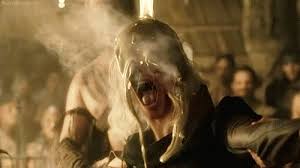 |
| Pictured: a medieval Sultan, looking pretty damned white. |
The King of Tars features a literal white-washing, in which the Sultan of Damascus is baptized and his dark skin turns white due to his new “holiness,” or “piety,” or something of that sort. Increasingly in modern media, however, a more subtle white-washing has occurred between the adaptation from book to screen--characters coded as people of color are suddenly white, or are perceived by some to be wrongfully casted as non-white. But this is not, as in the King of Tars, explicitly to rid these characters of sin, because in today’s society calling dark skin a “sin” is openly acknowledged as racist. And yet whitewashing still occurs--mostly, because white viewers cannot handle seeing good, decent protagonists who are people of color.
The vast majority of characters from M. Night Shyamalan’s (atrocious) film The Last Airbender, an adaptation of the wonderful Nickelodeon series Avatar: The Last Airbender, were made white rather than remaining based upon Inuit, Tibetan, and Chinese cultures; however, the villainous Fire Nation, originally based primarily on Japan, were cast entirely from desi actors and actresses. Suddenly the previously-Inuit protagonists were white, fighting off the mighty horde of brown invaders, an exact swap from the series and the majority of real-life conquests. Fan outcry was overwhelmingly against this choice, and the film was summarily panned, for good reason.
 |
| Ugggghhhhhhhhhhhhhhhhhh I'm so sorry Dev Patel |
An opposing scenario, however, took place in the Hunger Games movie--Katniss, who was implied in the book to be of Native American ancestry due to her “olive” skin and dark braided hair, was cast as white. There was a considerable amount of back-and-forth between supporters and opponents of the casting, but at the end of the day, as with The Last Airbender, the casting was set in stone.
So why do we whitewash? In both cases, this can be pinned on the sheer fact that white people have held power in this country for centuries; this is why we have racism, and this is why we whitewash. White people in this country do not like people of color to have power--or even to be seen as human.
The entire cast of Avatar: the Last Airbender were all of fictionalized cultures based upon real-life Asian and Native ones, and were extremely well-written. They were heroes, villains, one-off jokes--everything. They were greatly humanized and given extensive backstory. And quite a few of them were dark-skinned. But the minute their story is put to screen and this egalitarian view of non-whiteness is about to be shown off, that kind of humanity can only belong to white people. The villains, therefore, have to be non-white--it’s the only way we can root against them.
(And yes, a couple villains eventually become good guys, but holy shit this movie is so bad it basically doesn’t count.)
 |
| Look at that cinematography, and also that single rock in the middle of the shot. Glorious. |
The reason for the resulting outcry was that the fans of the show were accepting of this Asian-inspired environment: they read the cultural under-and-overtones accurately, and were tolerant of them, and even enthralled by them. When this was taken away, they noticed--especially fans who were themselves people of color. Their representation had been ripped out from under them, and they would fight tooth and nail to get it back.
In the case of Katniss, her situation is more ambiguous; she is never explicitly described as Native American, but what little we are told of her physical features subtly suggests that she shares some stereotypically Native features with her father. This subtlety is what ultimately resulted in her casting as white--if she was not explicitly declared non-white, the casting directors are given full license to make the sympathetic protagonist white without fear of repercussion. And indeed, there is very little outcry against Katniss’s casting outside of social justice communities on sites like Tumblr--it’s just not as noticed as the Last Airbender casting because it’s not as explicitly racist.
 |
| And in a bizarre twist, here is Katniss actually photoshopped to look darker rather than whiter. Because they know JLaw is by no means "olive-skinned." |
So, even though the characters in both situations are not literally dunked in water and rid of their non-whiteness, the fact that their goodness and person-ness as well-developed characters is taken from them purely because they are not white and therefore threaten white power structure--if white people see people of color being good and doing good things then they might--gasp--treat them like people!


















